HL-LHC is in the final stage of design and prototyping: all technologies for the hardware upgrade must be fully proven by beginning of 2017. This review covers the cornerstone of the upgrade plan, the new IR quadrupoles (MQXF), featuring 150 mm aperture and peak field in the range of 11.5 T. The previous technical reviews addressed the conductor, the preliminary design, including the engineering concepts and the cost and schedule (within the overall scope of HL-LHC).
The scope of this review is to examine:
- The magnet requirements and design status, including the cold mass with its interfaces (cryostats, electrical, hydraulic, mechanical, vacuum) and integration issues (cold mass and integration will be assessed at the level of preliminary design stage);
- The major design alternatives considered (conductor, aperture, length, operating temperature, etc.);
- The results of model magnets (including previous smaller aperture ones) and the status of prototype magnets;
- The conductor performance, procurement status and plans;
- The status of production tooling, finalization of design and procurement;
- The components’ procurement, status and plans;
- The test plan, QA/QC, and safety aspects;
- The strategy for magnet construction and/or procurement and the overall schedule (assuming the US contribution for Q1 and Q3 magnets);
- The risk registry and mitigation measures.
Review panel: Akira Yamamoto (KEK-CERN, Chair), Joe Minervini (MIT, Co-Chair), Arnaud Devred (ITER), Pasquale Fabbricatore (INFN), Mauricio de Lima Lopes (FNAL), Pierre Vedrine (CEA).
Giorgio Ambrosio (LARP-FNAL) and Ezio Todesco (CERN) are the link persons.
The review is scheduled on 7th to 10th June 2016, at CERN.
Useful links: WP3 website and QXF pages

